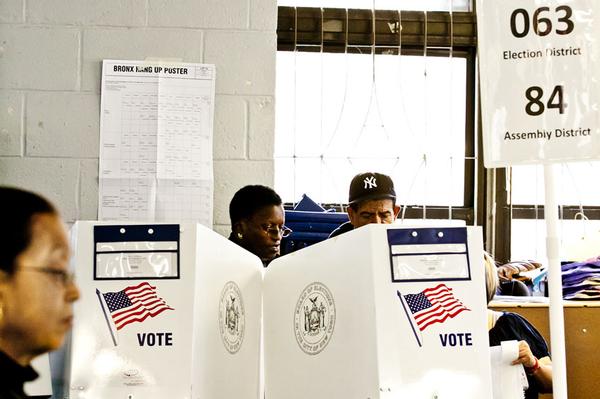
Photo by: Adi Talwar
Voters at the Mill Brook Houses polling site. Only about 13 percent of registered Bronx voters voted on the ballot questions, which dealt with casinos, veterans, mining, sewers and judges.
This article is the final Bronx installment in The Five Borough Ballot, a collaboration between City Limits, City & State and WNET’s MetroFocus. For a complete overview of the series, go here
Not only did the Bronx have the lowest voter turnout of any borough in the city this election, ballot initiatives were a losing proposition even among those who made it to the polls.
For decades, low voter-turnout has plagued the borough, particularly neighborhoods in the South Bronx, and that pattern continued this year. Of the 649,978 active registered Bronx voters as of Nov. 1, unofficial results (not including absentee, affidavit and military ballots) show 133,465 Bronxites cast ballots on Tuesday — a rate of 20.5 percent, compared to the city’s 22 percent turnout rate.
Queens had a turnout rate of 23.6 percent; Brooklyn, 25.8 percent; Manhattan, 26.6 percent; and Staten Island, 27 percent.
And when it came to the single most publicized question of six on the ballot — a now-successful proposition to allow up to seven full Vegas-style casinos in the state — Bronx voters weighed in at a lower rate than voters in any other borough.
Only 86,814 — or 65 percent — of people who voted in the Bronx on Tuesday gave a thumbs up or down to Proposition 1. In Staten Island, 85 percent voters weighed-in on the ballot measure, while 68 percent of voters in Brooklyn, 77 percent of voters in Manhattan; and 73 percent in Queens voted it either up or down.
Lower turnout in some areas
In some of the poorest parts of the Bronx, overall turnout rate was even lower than in the borough overall, and the rate of return on the ballot measures was also a lower percentage of the total votes cast.
In the 84th Assembly District, which includes Highbridge, Melrose, Longwood, Mott Haven, Port Morris and Hunts Point, voters turned out at a rate of 16 percent (9,847 people out of 59,188 active, registered voters).
A total of 4,926 people in the 84th AD weighed in on the ultimately successful gaming proposition, with yes votes outnumbering no votes more than three-to-one (3,908 to 1,018, respectively). And more people voted on Proposition 1 than any other in the 84th AD.
In the 84th AD’s 61st Election District, where the neighborhood anchor Camaguey Restaurant lies, the turnout rate among registered, active voters was a mere 5.8 percent. Only 31 of the 157 people who cast votes (19 percent) marked yes or no on the casino proposal, according to the unofficial BOE data.
Voters unaware
While a variety of factors contribute to low voter turnout and voters complained of small print for the ballot initiatives, not every polling site followed protocol for informing voters to flip the double-sided ballot over so they could read them.
Zuma Espinal, who voted at the Mill Brook Houses polling site, said she didn’t realize there were amendments on the back.
“If I knew, I would do it,” she said, though she had clearly learned about at least one of the issues. On the casino question she said, “I would have voted yes because it could have raised the economy.” However, she added that she would only support casinos located outside of the city.
Outside the Judge Gilbert Ramirez Apartments Mario Gonzalez, 78, said he voted in the mayoral and City Council races only. When asked about the questions on the back of the ballot, however, he said “That’s new for me. I didn’t know about them.”
According to BOE Executive Director Michael Ryan, there are rules in place to ensure that all voters are reminded about ballot measures such as the amendments presented on Tuesday.
“It is part of the protocol anytime we have to use the back of the ballot for our staff to remind voters that there are things on the back of the ballot,” he said, adding that information about how to instruct voters was provided to workers after they were trained on the issue.
No time to flip the page
But at Election Districts 58 and 59, located at Ramirez houses, no such instructions were given.
There, of the 329 people who voted in those two EDs, 143 — 43 percent — voted on Prop 1. However, at the Mitchel Houses polling site — where staff hung large samples of both sides of the ballot and reminded voters to look on the back — the rate was 30 percent.
Jose Ortega, who voted there, said he knew about the questions but could hardly read the small print and didn’t vote on them.
Emmanuel Polonia, 11, a student at South Bronx Preparatory School, was among those who hit the voting booth with his mother well-informed about the amendments. But even he forgot without a reminder.
Desiree Ford, 48, however, simply had more pressing issues on her mind. She’s concerned that her New York Housing Authority rent is going up but her city salary is not and that she could end up homeless.
When it came to the ballot measures, she said “I really didn’t care. I just wanted de Blasio … working people don’t have time for that.”








